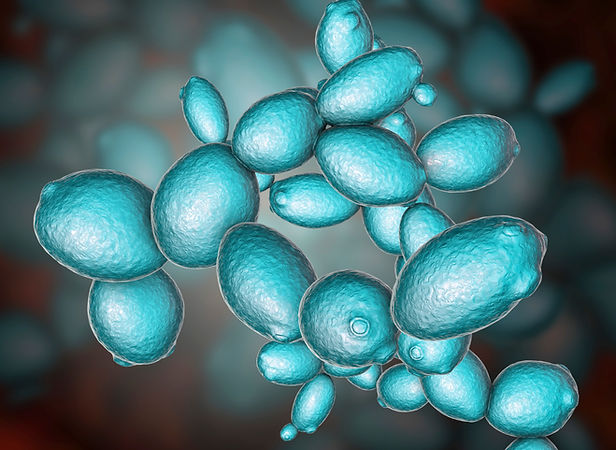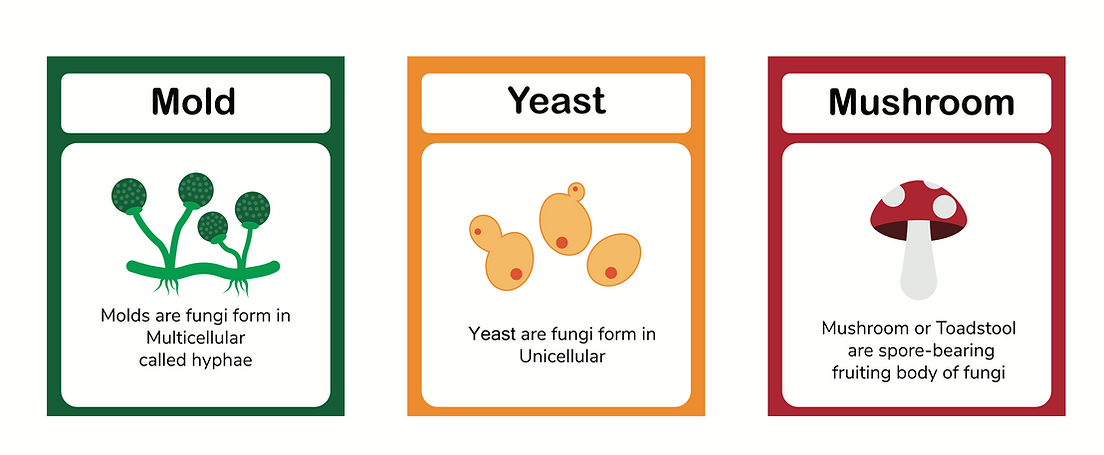FUNGI

CANDIDIASIS
CANDIDA AURIS
BLASTOMYCOSIS
VALLEY FEVER
C. GATTI
C. NEOFORMANS
HISTOPLASMOSIS
PARACOCCIDIOIDOMYCOSIS
WHAT ARE FUNGI?
Fungi are a kingdom of usually multicellular eukaryotic organisms that cannot make their own food and have important roles in nutrient cycling in an ecosystem. Fungi reproduce both sexually and asexually, and they also have symbiotic associations with plants and bacteria. However, they are also responsible for some diseases in plants and animals.
ASPERGILLOSIS
PNEUMOCYSTIS PNEUMONIA
MUCORMYCOSIS
TALAROMYCOSIS
Yeast and fungi are two types of organisms, which belong to the kingdom Fungi. Yeast is a type of fungi, which is unicellular, whereas fungi are mostly multicellular. Both yeast and fungi are saprotrophs, which secrete enzymes on decaying organic matter.


YEAST
The main difference between yeast and fungi is their structure. The general structure of yeast is a rounded shape, whereas that of fungi is tubular with filamentous hyphae.
Together with bacteria, fungi are the major decomposers of organic materials in the soil. They degrade complex organic matter into simple organic and inorganic compounds. In doing so, they help recycle carbon, nitrogen, phosphorous, and other elements for reuse by other organisms.
Researchers have measured up to 8 miles of fungi filaments in one teaspoon of soil.
Together with bacteria, fungi are the major decomposers of organic materials in the soil. They degrade complex organic matter into simple organic and inorganic compounds. In doing so, they help recycle carbon, nitrogen, phosphorous, and other elements for reuse by other organisms.
They are found mostly in soil, on objects contaminated with soil, on plants and animals, and on the skin, and they may also be airborne. Fungi like to feed by absorbing nutrients from their surroundings. Fungi may exist as molds, yeasts, or mushrooms and may alternate between the two forms, depending on environmental conditions.
There are millions of fungal species and most types are not dangerous, but there are some that can infect humans and can be lethal. For example, some fungi, like many types of mushrooms, are edible. Other types of fungi, like aspergillus, can be extremely dangerous and lead to life-threatening diseases.
More than 2,000 new fungi are discovered each year, from a variety of sources, including a human fingernail.
TYPES OF FUNGI
Fungi are subdivided based on their life cycles, the presence or structure of their fruiting body, and the arrangement of and type of spores (reproductive or distributional cells) they produce.
The three major groups of fungi are:

-
Multicellular filamentous molds.
-
Macroscopic filamentous fungi that form large fruiting bodies. Sometimes the group is referred to as ‘mushrooms’, but the mushroom is just the part of the fungus we see above ground which is also known as the fruiting body.
-
Single-celled microscopic yeasts.
There are about 300 fungi that are known to make people sick. Fungal spores when inhaled can lead to fungal infections that affect the whole body. Fungal infections can affect anyone, and they can appear on several parts of the body. Athlete’s foot, thrush, and vaginal yeast infections are just a few examples.
Different types of fungi can cause fungal infections. In some cases, fungi that aren’t typically found on or inside your body can colonize it and cause an infection. In other cases, fungi that are normally present on or inside your body can multiply out of control and cause an infection.
A fungus known as the honey mushroom is the largest living organism on the planet. It is believed to be about 2400 years old and covers over 2000 acres. Interestingly enough, it kills trees as it spreads.
Fungal infections can be contagious. They can spread from one person to another. Fungal diseases in humans are called mycoses; they include such disorders as histoplasmosis, coccidioidomycosis (valley fever), and blastomycosis.
Overview of FUNGAL INFECTIONS & DISEASES
Fungi can affect animals, including humans, in several ways. A mycosis is a fungal disease that results from infection and direct damage. Fungi attack animals directly by colonizing and destroying tissues. Mycotoxicosis is the poisoning of humans (and other animals) by foods contaminated by fungal toxins (mycotoxins). Mycetismus describes the ingestion of preformed toxins in poisonous mushrooms. In addition, individuals who display hypersensitivity to molds and spores develop strong and dangerous allergic reactions. Fungal infections are generally very difficult to treat because, unlike bacteria, fungi are eukaryotes. Antibiotics only target prokaryotic cells, whereas compounds that kill fungi also harm the eukaryotic animal host.
Many fungal infections are superficial; that is, they occur on the animal’s skin. Termed cutaneous (“skin”) mycoses, can have devastating effects. For example, the decline of the world’s frog population in recent years may be caused by the fungus Batrachochytrium dendrobatidis, which infects the skin of frogs and presumably interferes with the gaseous exchange. Similarly, more than a million bats in the United States have been killed by white-nose syndrome, which appears as a white ring around the mouth of the bat. It is caused by the cold-loving fungus Geomyces destructans, which disseminates its deadly spores in caves where bats hibernate. Mycologists are researching the transmission, mechanism, and control of G. destructans to stop its spread.
Fungi that cause the superficial mycoses of the epidermis, hair, and nails rarely spread to the underlying tissue. These fungi are often misnamed “dermatophytes”, from the Greek word dermis meaning skin and phyte meaning plant, although they are not plants. Dermatophytes are also called “ringworms” because of the red ring they cause on the skin. They secrete extracellular enzymes that break down keratin (a protein found in hair, skin, and nails), causing conditions such as athlete’s foot and jock itch. These conditions are usually treated with over-the-counter topical creams and powders; they are easily cleared. More persistent superficial mycoses may require prescription oral medications.

Mycosis infection: (a) Ringworm presents as a red ring on skin; (b) Trichophyton violaceum, shown in this bright field light micrograph, causes superficial mycoses on the scalp; (c) Histoplasma capsulatum is an ascomycete that infects airways and causes symptoms similar to influenza.
Over a billion people suffer from superficial fungal infections, while life-threatening fungal infections and systemic mycoses cause an estimated 1.5 million deaths worldwide each year. Systemic mycoses exact an enormous burden on public health and are often overlooked, particularly, the serious risks and economic costs associated with life-threatening invasive fungal infections such as invasive candidiasis and aspergillosis. These infections are associated with high mortality rates, affecting the growing population of immunocompromised patients, such as HIV/AIDS and cancer chemotherapy patients.
Systemic mycoses spread to internal organs, most commonly entering the body through the respiratory system. For example, coccidioidomycosis (valley fever) is commonly found in the southwestern United States where the fungus resides in the dust.
Coccidioidomycosis (Valley Fever)

Once inhaled, the spores develop in the lungs and cause symptoms similar to those of tuberculosis. Histoplasmosis is caused by the dimorphic fungus Histoplasma capsulatum. It also causes pulmonary infections. In rarer cases, it causes swelling of the membranes of the brain and spinal cord.
Opportunistic mycoses are fungal infections that are either common in all environments or are part of the normal biota. They mainly affect individuals who have a compromised immune system. Patients in the late stages of AIDS suffer from opportunistic mycoses that can be life-threatening. The yeast Candida sp., a common member of the natural biota, can grow unchecked and infect the vagina or mouth (oral thrush) if the pH of the surrounding environment, the person’s immune defenses, or the normal population of bacteria is altered.
These diseases can be mild, characterized by an upper respiratory infection, or severe, involving the bloodstream and every organ system. Fungi may cause devastating disease in persons whose defenses against infection have been weakened by malnutrition, cancer, or the use of immunosuppressive drugs. Specific types of antibiotics known as antifungals are effective in their treatment.
Fungi can cause many different types of illnesses, including:
-
Asthma or allergies.
-
Rashes or infections on the skin and nails
-
Lung infections (pneumonia), with symptoms similar to the flu or tuberculosis
-
Bloodstream infections
-
Meningitis
15% of all vaccines and therapeutic proteins are made in yeast.

TREATING FUNGAL INFECTIONS
Antifungal drugs treat fungal infections by killing or stopping the growth of dangerous fungi in the body. Fungi, like bacteria, can develop antibiotic resistance, when germs like bacteria and fungi develop the ability to defeat the drugs designed to kill them.
Antifungal resistance occurs when fungi no longer respond to antifungal drugs. Resistance can also develop over time when fungi are exposed to antifungal drugs. This resistance can occur when antifungal drugs are used improperly to treat sick people (e.g., when dosages are too low, or when treatment courses are not long enough), or even when antifungal drugs are used properly.
Only three types of antifungal drugs currently exist, so antifungal resistance can severely limit treatment options. Some types of fungi, like Candida Auris, can become resistant to all three drug types. Resistance is especially concerning for patients with invasive fungal infections; severe infections that affect the blood, heart, brain, eyes, or other parts of the body; because these are serious infections that may be more difficult to treat if they are resistant and if antifungal treatment is limited. For example, bloodstream infections with the fungus Candida (a yeast) that are resistant to treatment can cause serious health problems, including disability and death.
The incredible, board-certified doctors at Apex, prescribe antifungal drugs appropriately and document the dose, duration, and indication for every antifungal prescription. They test for antifungal resistance in patients with the invasive disease who are not improving with first-line antifungal drugs. Furthermore, Apex Physicians are keenly aware of resistance patterns, including antifungal resistance in the community, and therefore ensure adherence to infection prevention and control guidelines.

_1_edited.png)